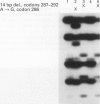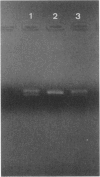Abstract
In a retrospective study of the mutational spectrum of the p53 gene in oral squamous cell carcinoma, 80 primary tumours diagnosed in 1980-90 were included. Using polymerase chain reaction/single strand conformation polymorphism (PCR/SSCP) analysis 47 mutations were found distributed in 39 of the tumours (49%). Unexpectedly, the majority of the mutations (29/47; 62%) were found in exon 8, and at sequencing 17 of them showed a 14 bp deletion in codons 287-292, causing formation of a stop codon and accordingly a truncated protein lacking the C-terminal. The majority of the patients with the 14 bp deletion were women (13/17), and it seemed as though certain potential risk factors for carcinoma of the head and neck were less common in this group.
Full text
PDF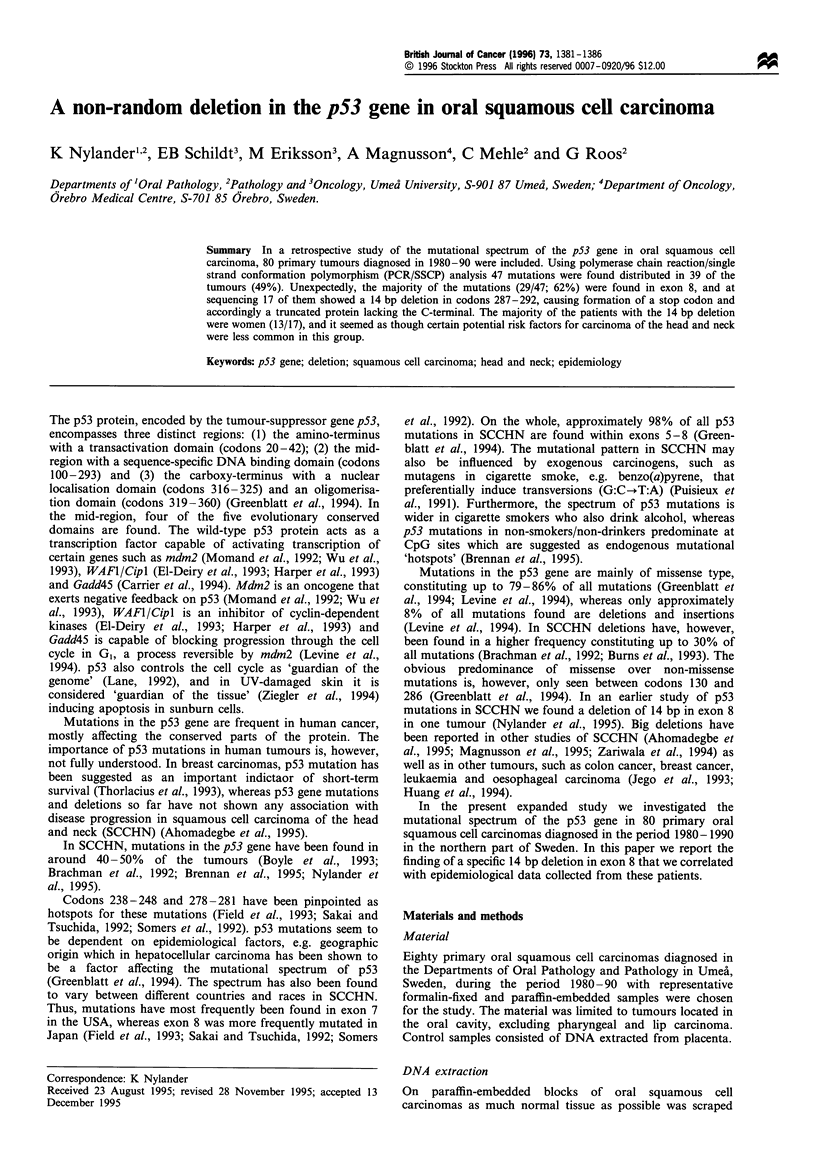
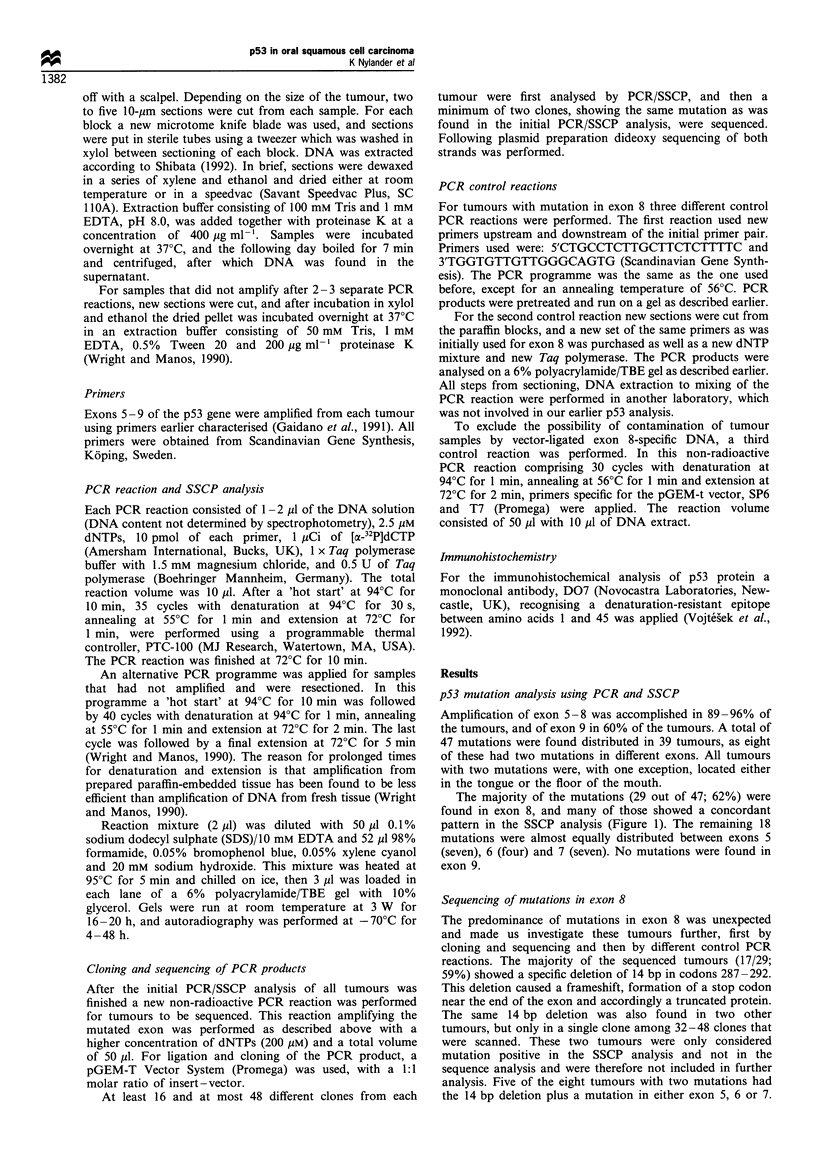
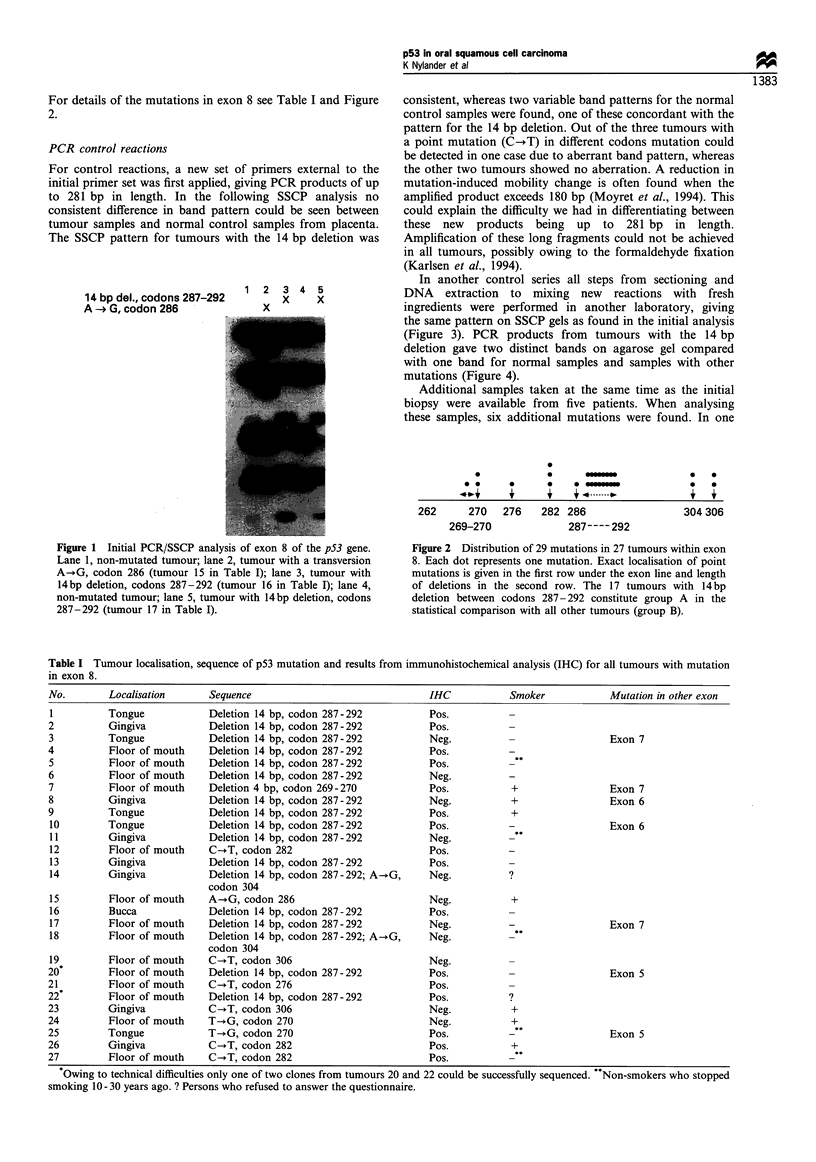
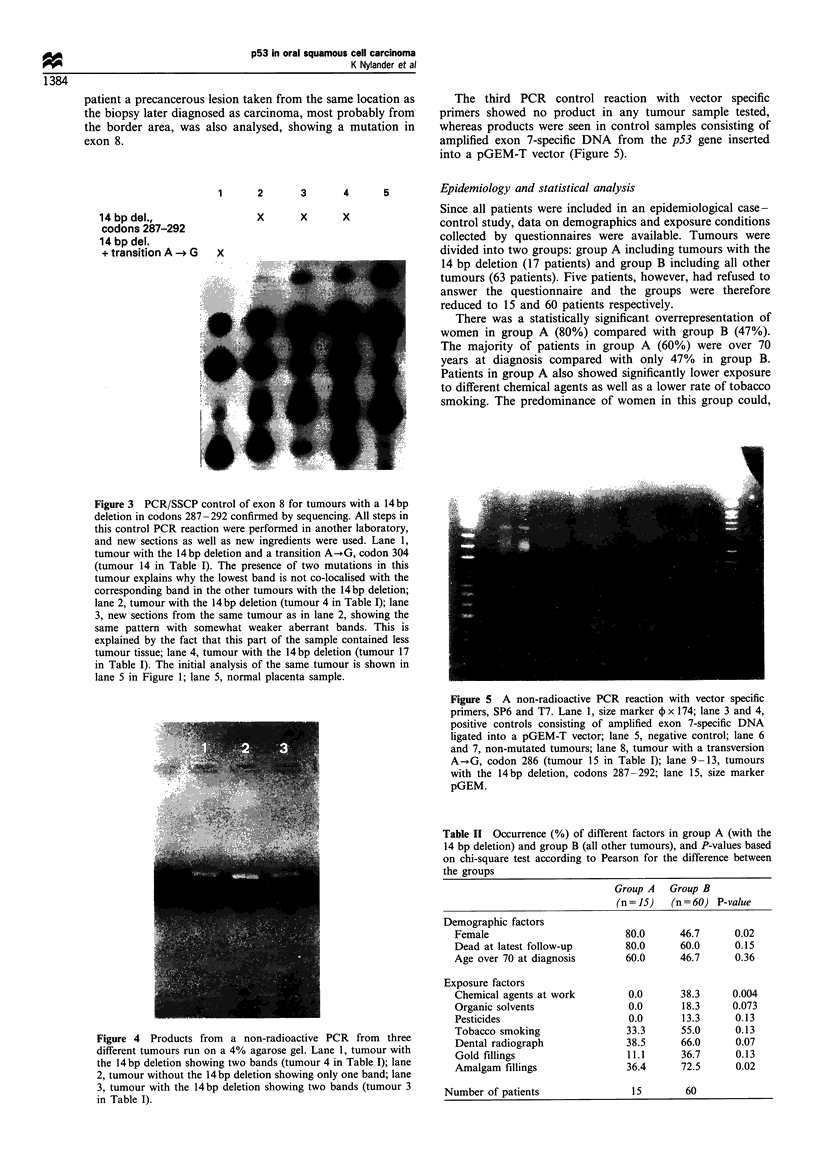
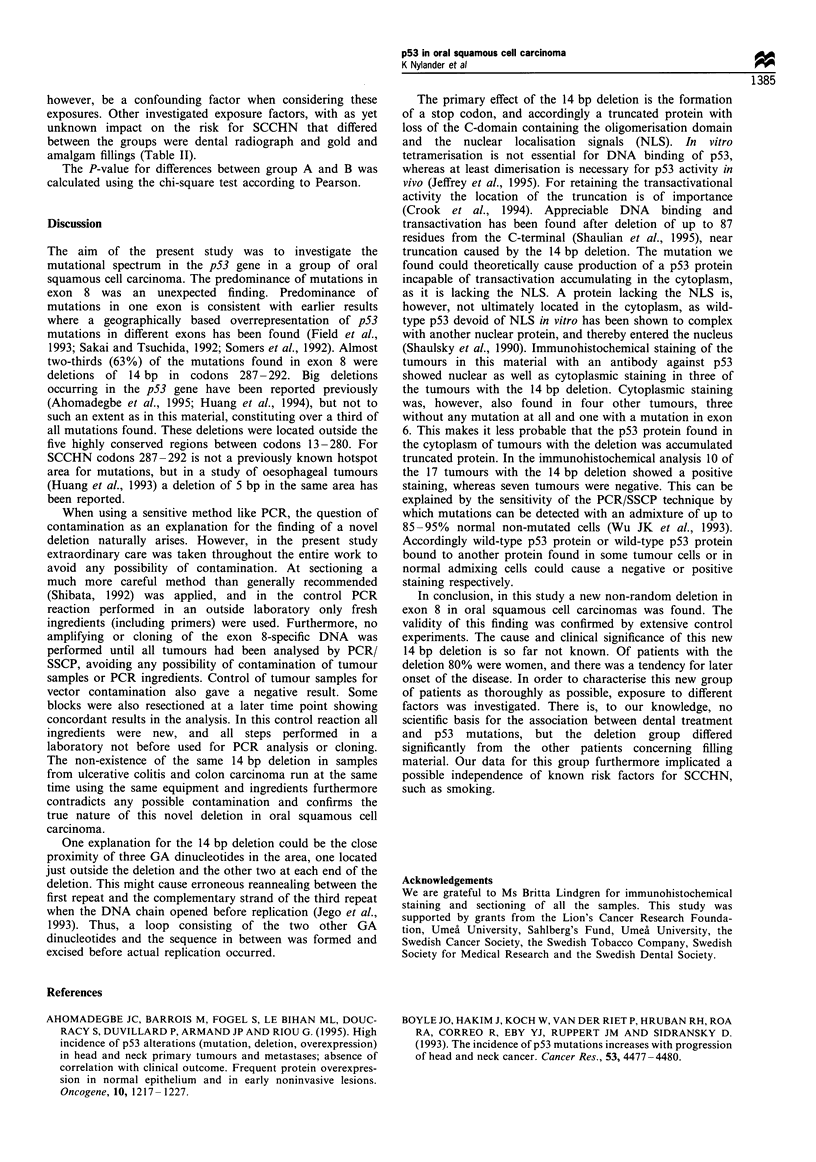
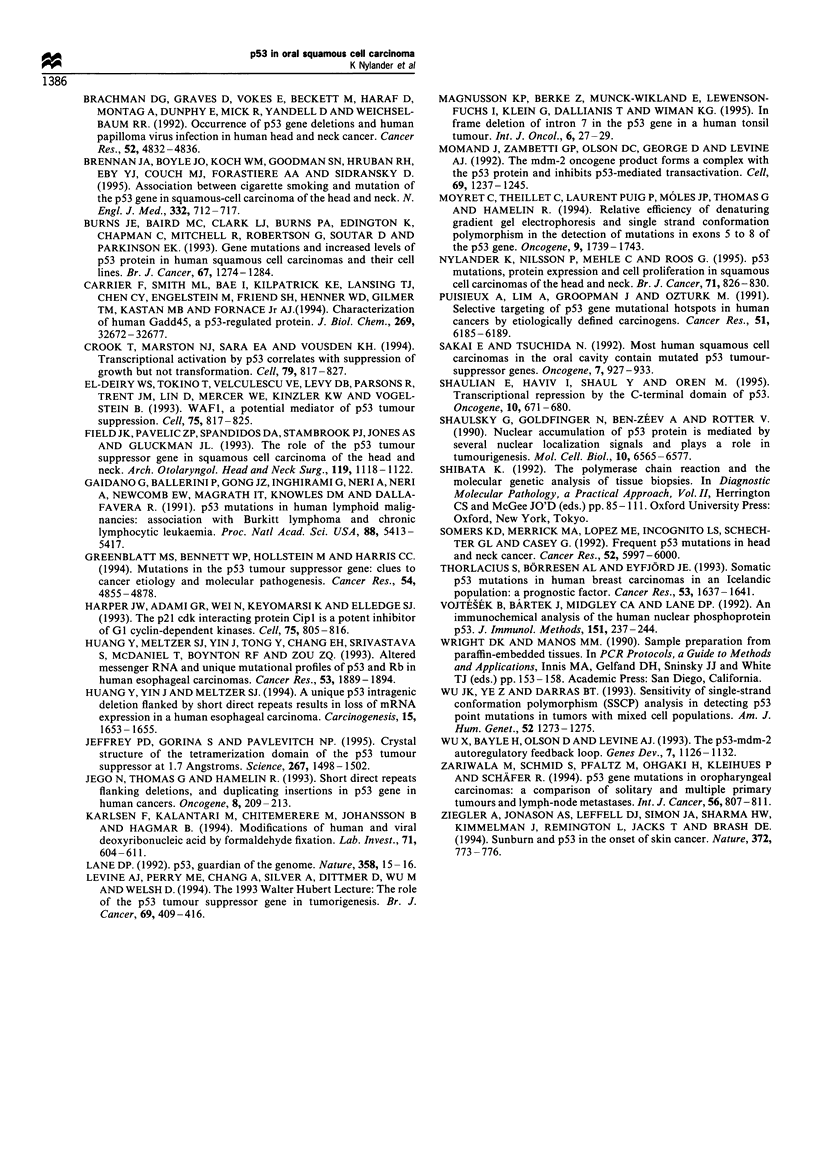
Images in this article
Selected References
These references are in PubMed. This may not be the complete list of references from this article.
- Ahomadegbe J. C., Barrois M., Fogel S., Le Bihan M. L., Douc-Rasy S., Duvillard P., Armand J. P., Riou G. High incidence of p53 alterations (mutation, deletion, overexpression) in head and neck primary tumors and metastases; absence of correlation with clinical outcome. Frequent protein overexpression in normal epithelium and in early non-invasive lesions. Oncogene. 1995 Mar 16;10(6):1217–1227. [PubMed] [Google Scholar]
- Boyle J. O., Hakim J., Koch W., van der Riet P., Hruban R. H., Roa R. A., Correo R., Eby Y. J., Ruppert J. M., Sidransky D. The incidence of p53 mutations increases with progression of head and neck cancer. Cancer Res. 1993 Oct 1;53(19):4477–4480. [PubMed] [Google Scholar]
- Brachman D. G., Graves D., Vokes E., Beckett M., Haraf D., Montag A., Dunphy E., Mick R., Yandell D., Weichselbaum R. R. Occurrence of p53 gene deletions and human papilloma virus infection in human head and neck cancer. Cancer Res. 1992 Sep 1;52(17):4832–4836. [PubMed] [Google Scholar]
- Brennan J. A., Boyle J. O., Koch W. M., Goodman S. N., Hruban R. H., Eby Y. J., Couch M. J., Forastiere A. A., Sidransky D. Association between cigarette smoking and mutation of the p53 gene in squamous-cell carcinoma of the head and neck. N Engl J Med. 1995 Mar 16;332(11):712–717. doi: 10.1056/NEJM199503163321104. [DOI] [PubMed] [Google Scholar]
- Burns J. E., Baird M. C., Clark L. J., Burns P. A., Edington K., Chapman C., Mitchell R., Robertson G., Soutar D., Parkinson E. K. Gene mutations and increased levels of p53 protein in human squamous cell carcinomas and their cell lines. Br J Cancer. 1993 Jun;67(6):1274–1284. doi: 10.1038/bjc.1993.238. [DOI] [PMC free article] [PubMed] [Google Scholar]
- Carrier F., Smith M. L., Bae I., Kilpatrick K. E., Lansing T. J., Chen C. Y., Engelstein M., Friend S. H., Henner W. D., Gilmer T. M. Characterization of human Gadd45, a p53-regulated protein. J Biol Chem. 1994 Dec 23;269(51):32672–32677. [PubMed] [Google Scholar]
- Crook T., Marston N. J., Sara E. A., Vousden K. H. Transcriptional activation by p53 correlates with suppression of growth but not transformation. Cell. 1994 Dec 2;79(5):817–827. doi: 10.1016/0092-8674(94)90071-x. [DOI] [PubMed] [Google Scholar]
- Field J. K., Pavelic Z. P., Spandidos D. A., Stambrook P. J., Jones A. S., Gluckman J. L. The role of the p53 tumor suppressor gene in squamous cell carcinoma of the head and neck. Arch Otolaryngol Head Neck Surg. 1993 Oct;119(10):1118–1122. doi: 10.1001/archotol.1993.01880220064009. [DOI] [PubMed] [Google Scholar]
- Gaidano G., Ballerini P., Gong J. Z., Inghirami G., Neri A., Newcomb E. W., Magrath I. T., Knowles D. M., Dalla-Favera R. p53 mutations in human lymphoid malignancies: association with Burkitt lymphoma and chronic lymphocytic leukemia. Proc Natl Acad Sci U S A. 1991 Jun 15;88(12):5413–5417. doi: 10.1073/pnas.88.12.5413. [DOI] [PMC free article] [PubMed] [Google Scholar]
- Greenblatt M. S., Bennett W. P., Hollstein M., Harris C. C. Mutations in the p53 tumor suppressor gene: clues to cancer etiology and molecular pathogenesis. Cancer Res. 1994 Sep 15;54(18):4855–4878. [PubMed] [Google Scholar]
- Harper J. W., Adami G. R., Wei N., Keyomarsi K., Elledge S. J. The p21 Cdk-interacting protein Cip1 is a potent inhibitor of G1 cyclin-dependent kinases. Cell. 1993 Nov 19;75(4):805–816. doi: 10.1016/0092-8674(93)90499-g. [DOI] [PubMed] [Google Scholar]
- Huang Y., Meltzer S. J., Yin J., Tong Y., Chang E. H., Srivastava S., McDaniel T., Boynton R. F., Zou Z. Q. Altered messenger RNA and unique mutational profiles of p53 and Rb in human esophageal carcinomas. Cancer Res. 1993 Apr 15;53(8):1889–1894. [PubMed] [Google Scholar]
- Huang Y., Yin J., Meltzer S. J. A unique p53 intragenic deletion flanked by short direct repeats results in loss of mRNA expression in a human esophageal carcinoma. Carcinogenesis. 1994 Aug;15(8):1653–1655. doi: 10.1093/carcin/15.8.1653. [DOI] [PubMed] [Google Scholar]
- Jeffrey P. D., Gorina S., Pavletich N. P. Crystal structure of the tetramerization domain of the p53 tumor suppressor at 1.7 angstroms. Science. 1995 Mar 10;267(5203):1498–1502. doi: 10.1126/science.7878469. [DOI] [PubMed] [Google Scholar]
- Jego N., Thomas G., Hamelin R. Short direct repeats flanking deletions, and duplicating insertions in p53 gene in human cancers. Oncogene. 1993 Jan;8(1):209–213. [PubMed] [Google Scholar]
- Karlsen F., Kalantari M., Chitemerere M., Johansson B., Hagmar B. Modifications of human and viral deoxyribonucleic acid by formaldehyde fixation. Lab Invest. 1994 Oct;71(4):604–611. [PubMed] [Google Scholar]
- Levine A. J., Perry M. E., Chang A., Silver A., Dittmer D., Wu M., Welsh D. The 1993 Walter Hubert Lecture: the role of the p53 tumour-suppressor gene in tumorigenesis. Br J Cancer. 1994 Mar;69(3):409–416. doi: 10.1038/bjc.1994.76. [DOI] [PMC free article] [PubMed] [Google Scholar]
- Momand J., Zambetti G. P., Olson D. C., George D., Levine A. J. The mdm-2 oncogene product forms a complex with the p53 protein and inhibits p53-mediated transactivation. Cell. 1992 Jun 26;69(7):1237–1245. doi: 10.1016/0092-8674(92)90644-r. [DOI] [PubMed] [Google Scholar]
- Moyret C., Theillet C., Puig P. L., Molés J. P., Thomas G., Hamelin R. Relative efficiency of denaturing gradient gel electrophoresis and single strand conformation polymorphism in the detection of mutations in exons 5 to 8 of the p53 gene. Oncogene. 1994 Jun;9(6):1739–1743. [PubMed] [Google Scholar]
- Nylander K., Nilsson P., Mehle C., Roos G. p53 mutations, protein expression and cell proliferation in squamous cell carcinomas of the head and neck. Br J Cancer. 1995 Apr;71(4):826–830. doi: 10.1038/bjc.1995.159. [DOI] [PMC free article] [PubMed] [Google Scholar]
- Puisieux A., Lim S., Groopman J., Ozturk M. Selective targeting of p53 gene mutational hotspots in human cancers by etiologically defined carcinogens. Cancer Res. 1991 Nov 15;51(22):6185–6189. [PubMed] [Google Scholar]
- Sakai E., Tsuchida N. Most human squamous cell carcinomas in the oral cavity contain mutated p53 tumor-suppressor genes. Oncogene. 1992 May;7(5):927–933. [PubMed] [Google Scholar]
- Shaulian E., Haviv I., Shaul Y., Oren M. Transcriptional repression by the C-terminal domain of p53. Oncogene. 1995 Feb 16;10(4):671–680. [PubMed] [Google Scholar]
- Shaulsky G., Goldfinger N., Ben-Ze'ev A., Rotter V. Nuclear accumulation of p53 protein is mediated by several nuclear localization signals and plays a role in tumorigenesis. Mol Cell Biol. 1990 Dec;10(12):6565–6577. doi: 10.1128/mcb.10.12.6565. [DOI] [PMC free article] [PubMed] [Google Scholar]
- Somers K. D., Merrick M. A., Lopez M. E., Incognito L. S., Schechter G. L., Casey G. Frequent p53 mutations in head and neck cancer. Cancer Res. 1992 Nov 1;52(21):5997–6000. [PubMed] [Google Scholar]
- Thorlacius S., Börresen A. L., Eyfjörd J. E. Somatic p53 mutations in human breast carcinomas in an Icelandic population: a prognostic factor. Cancer Res. 1993 Apr 1;53(7):1637–1641. [PubMed] [Google Scholar]
- Vojtesek B., Bártek J., Midgley C. A., Lane D. P. An immunochemical analysis of the human nuclear phosphoprotein p53. New monoclonal antibodies and epitope mapping using recombinant p53. J Immunol Methods. 1992 Jul 6;151(1-2):237–244. doi: 10.1016/0022-1759(92)90122-a. [DOI] [PubMed] [Google Scholar]
- Wu J. K., Ye Z., Darras B. T. Sensitivity of single-strand conformation polymorphism (SSCP) analysis in detecting p53 point mutations in tumors with mixed cell populations. Am J Hum Genet. 1993 Jun;52(6):1273–1275. [PMC free article] [PubMed] [Google Scholar]
- Wu X., Bayle J. H., Olson D., Levine A. J. The p53-mdm-2 autoregulatory feedback loop. Genes Dev. 1993 Jul;7(7A):1126–1132. doi: 10.1101/gad.7.7a.1126. [DOI] [PubMed] [Google Scholar]
- Zariwala M., Schmid S., Pfaltz M., Ohgaki H., Kleihues P., Schäfer R. p53 gene mutations in oropharyngeal carcinomas: a comparison of solitary and multiple primary tumours and lymph-node metastases. Int J Cancer. 1994 Mar 15;56(6):807–811. doi: 10.1002/ijc.2910560608. [DOI] [PubMed] [Google Scholar]
- Ziegler A., Jonason A. S., Leffell D. J., Simon J. A., Sharma H. W., Kimmelman J., Remington L., Jacks T., Brash D. E. Sunburn and p53 in the onset of skin cancer. Nature. 1994 Dec 22;372(6508):773–776. doi: 10.1038/372773a0. [DOI] [PubMed] [Google Scholar]
- el-Deiry W. S., Tokino T., Velculescu V. E., Levy D. B., Parsons R., Trent J. M., Lin D., Mercer W. E., Kinzler K. W., Vogelstein B. WAF1, a potential mediator of p53 tumor suppression. Cell. 1993 Nov 19;75(4):817–825. doi: 10.1016/0092-8674(93)90500-p. [DOI] [PubMed] [Google Scholar]



